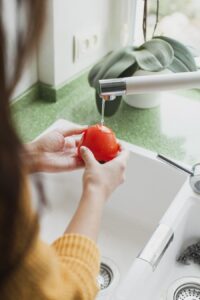Scripture: Genesis 3-4
Learning Objectives:
- Students will review the story of the first sins, focusing especially on the mentions of gardens and growing food
- Students will learn the best way to clean fruits and vegetables so they are safe to eat
- Students will participate in an activity that allows them to practice cleaning fruits and vegetables properly

Guiding Question: How do you clean vegetables and fruits so they are safe to eat?
Materials: scrub brushes, visibly dirt produce (potatoes usually have visible dirt), water
Procedure: Review the story of the first sins, focusing especially on the mentions of gardens and growing food. Share with students that fresh produce can be covered in dirt and germs. (If students are young, you may also need to explain how germs can make people sick.) Teach students the importance of making sure all fruits and vegetables are washed thoroughly before eating them. Give each students a dirty potato. Explain that while we can see dirt, we cannot see germs. Ask students for ideas about the best way to wash a fruit or vegetable to make sure all the dirt and all of the germs are washed away. Give each student a scrub brush. Have them share sinks or tubs of water and scrub all of the dirt and germs off of the potato. As students are working go around and give tips to students who are missing areas of their potato.
Additional Question: How can fruits and vegetables be cleaned when the tap water is unsafe to drink?
Supplemental Activity: Have students research the best way to clean fruits and vegetables when the tap water is unsafe to drink. After finding the best method, have students clean a potato using this method. (Please note: Most methods involve handling bleach. Bleach should only be handled by adults and all safety pro cautions should be taken.
